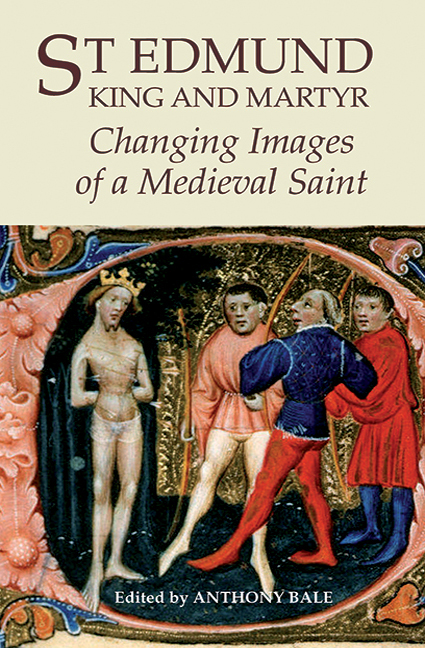Book contents
- Frontmatter
- Contents
- Preface
- List of Contributors
- List of Abbreviations
- Introduction: St Edmund's Medieval Lives
- 1 King, Martyr and Virgin: Imitatio Christi in Ælfric's Life of St Edmund
- 2 Chronology, Genealogy and Conversion: The Afterlife of St Edmund in the North
- 3 Geoffrey of Wells’ Liber de infantia sancti Edmundi and the ‘Anarchy’ of King Stephen's Reign
- 4 Music and Identity in Medieval Bury St Edmunds
- 5 Medieval images of St Edmund in Norfolk Churches
- 6 John Lydgate's Lives of Ss Edmund and Fremund: Politics, Hagiography and Literature
- 7 St Edmund in Fifteenth-Century London: The Lydgatian Miracles of St Edmund
- 8 The Later Lives of St Edmund: John Lydgate to John Stow
- Select Bibliography
- Index
- Miscellaneous Endmatter
3 - Geoffrey of Wells’ Liber de infantia sancti Edmundi and the ‘Anarchy’ of King Stephen's Reign
Published online by Cambridge University Press: 11 May 2017
- Frontmatter
- Contents
- Preface
- List of Contributors
- List of Abbreviations
- Introduction: St Edmund's Medieval Lives
- 1 King, Martyr and Virgin: Imitatio Christi in Ælfric's Life of St Edmund
- 2 Chronology, Genealogy and Conversion: The Afterlife of St Edmund in the North
- 3 Geoffrey of Wells’ Liber de infantia sancti Edmundi and the ‘Anarchy’ of King Stephen's Reign
- 4 Music and Identity in Medieval Bury St Edmunds
- 5 Medieval images of St Edmund in Norfolk Churches
- 6 John Lydgate's Lives of Ss Edmund and Fremund: Politics, Hagiography and Literature
- 7 St Edmund in Fifteenth-Century London: The Lydgatian Miracles of St Edmund
- 8 The Later Lives of St Edmund: John Lydgate to John Stow
- Select Bibliography
- Index
- Miscellaneous Endmatter
Summary
Though much new hagiography was produced at Bury St Edmunds in the twelfth century, relatively little of this effort was put into writing up contemporary events. It is true that Osbert of Clare (d. in or after 1158) compiled, at the request of Abbot Anselm (1121–48), a brief collection of the miracles that the abbey's patron saint had performed in recent times, and that some anonymous writers recorded a few more. However, the abbey's artists and writers generally concentrated on revising and enhancing older texts. In the 1120s, for example, the makers of the famous Morgan Manuscript (New York, Pierpont Morgan Library MS M.736) rewrote the collection of the miracles of St Edmund that ‘Archdeacon Hermann’ had begun during the time of Abbot Baldwin (d. 1097), and they illustrated both that text and Abbo's Passio S. Eadmundi with a lavish set of illuminations. In about 1180 Nicholas of Wallingford seems to have redrafted the fundamental text on which the cult depended, Abbo's Passio. In the 1190s Abbot Samson (1182–1211) rephrased the Morgan miracula, integrating what survives of Osbert's Liber miraculorum; and at some point in the final quarter of the century Denis Piramus reworked much of the received corpus as a poem in Old French. The upshot is that the sources for the twelfth century, though abundant, typically provide oblique glances at the contemporary scene. They say relatively little about what was taking place at Edmund's shrine, especially for long periods in the middle and latter half of the century, but they can yield useful insights into the times in which they were written through close analysis of nuances of detail and shifts of emphasis in their representations of the distant past. Some of these materials, especially the paintings, have been the subject of profitable analyses of this type. The present essay continues this work by re-examining the mid-eleventh-century Liber de infantia sancti Edmundi by Geoffrey of Wells, another of the several texts that attempt to enhance Abbo's Passio. Advancing a new approach, this essay argues that the ‘Anarchy’ of King Stephen's reign was the decisive factor in the development of this work's novel but influential ideas about the saint's origins. It will be useful to begin, however, by discussing De infantia's date, its author, its contents and its audience.
- Type
- Chapter
- Information
- St Edmund, King and MartyrChanging Images of a Medieval Saint, pp. 63 - 86Publisher: Boydell & BrewerPrint publication year: 2009

